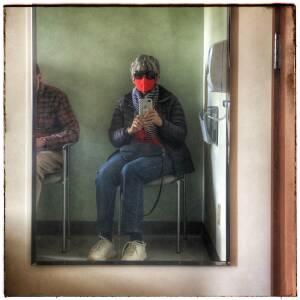Gelli Plate Prints
I took a class today to learn how to make gelli plate monoprints. A gelli plate is a soft acrylic sheet. The photo shows the basic process: you ink the plate, put down your interesting objects (in this case, leaves), and press a piece of paper by hand over the whole thing. The instructor is holding the result of the first pull--there is blank space where the leaves covered up the paint, giving you a lovely silhouette which you can use as a base layer to keep printing.
When the leaves are peeled off the plate in the next step, there is a detailed image of them left on the surface. That, in turn, can be used to print again, either over the first image or anywhere else. There might be one more ghost left on the plate after that, but then it's on to the next idea.
We also learned a bit about image transfer, which is how I got the lettering in the piece in the Extras. It is a very unpredictable technique, totally dependent on the quality of ink in the image you are trying to use. I never did get it to work on photographs.
Gelli printing is an inexact process at best, so don't get too attached to your masterpiece. Embrace every design opportunity (what I used to call mistakes). It was fun to lose myself in a day of playing with paint. I'm not sure if I would continue to work with this process. It hurts my brain to think about positive/negative reversal. I should at least try it a couple times at home before I forget how to do the whole thing.
The Extra shows a few of the pieces I made. It's easy to make dozens and dozens. What's hard is to figure out how to get the effect you want! I tried leaves, stencils, masks, transfers, and printing multiple layers. There were only five of us in the class, so we got plenty of time to work and plenty of coaching. And I'm exhausted. I haven't done anything this intense for a really long time.


Comments
Sign in or get an account to comment.


